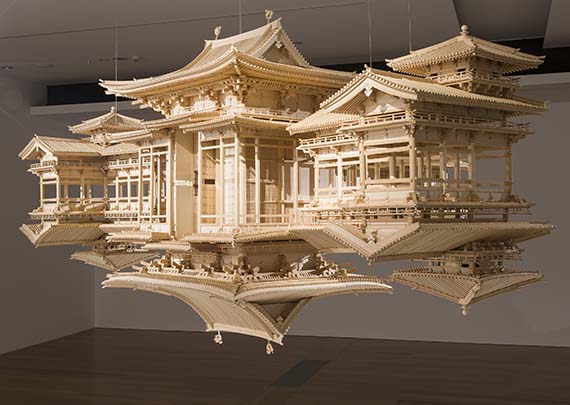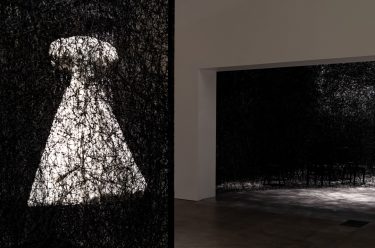
This stunning APT7 work by Japanese artist Takahiro Iwasaki was recently acquired for the Gallery’s Collection… however, there is more to this sculpture than its sheer beauty.
Takahiro Iwasaki’s Reflection Model (Perfect Bliss) 2010–12 is an intricate miniature recreation of Phoenix Hall, part of Japan’s Byodo-in Temple complex. It reproduces the building’s reflection in its traditional mirror pond as a physical object, and is presented suspended from the ceiling, appearing as a three-dimensional mirrored image floating in space. This dreamlike doubling is significant, inviting consideration of the work beyond the artist’s superb technical skill.
Byodo-in, near Kyoto, is part of the iconography of everyday life in Japan. Its image appears on the 10 yen coin, and the phoenixes that adorn the temple’s central hall are represented on the 10 000 yen note. As one reviewer has commented, however, this exemplary oriental structure also ‘belong[s] to the meditative sphere that Westerners qualify as “Japanese”’. (1) This is more problematic territory, for while the subject of the Phoenix Hall can be read in terms of the everyday in Japan, in a ‘globalised’ contemporary art context it bears an uneasy relationship to exotic conceptions of Japan, and Asia in general, that continue to characterise the Western mindset. And indeed, this is reciprocated in Japan’s perception of its own national identity.
When Iwasaki’s rendering of the temple is encountered as an object in space, a further paradox arises. Critic Noi Sawaragi has noted that Iwasaki’s work often has both an element of surprise and the capacity for ‘drawing the act of “observing” to the fore’. (2) These effects differ in a temporal sense, surprise being immediate and observation gradual. A similar tension animates the act of looking at this work, which presents unitary volume and minute detail in the same moment. In contrast to traditional aesthetic contemplation, which takes into consideration a concrete relationship between a whole and its parts, Reflection Model (Perfect Bliss) provokes what Sawaragi describes as the ‘differentiated movement of the eyeball’. (3) Perception is not only visual but also corporeal; seeing, too, is a physical sensation.
These contradictions are appropriate to the device of the mirror. Moreover, they are helpful in considering Iwasaki’s work’s relationship to orientalism, his specificity as an artist, and the development of Japanese modernity. Iwasaki lives and works in Hiroshima and has commented on having been ‘brought up with the reflection of the city’s inscribed memory, which is the fact that the one whole city vanished in a few seconds’. Curator Mami Kataoka sees this as precipitating his evocations of architecture’s fragility and ephemerality, and the possibility of structures that are venerated to the point of forgetting; they begin to lose their presence as buildings and become reduced to an idea, a mirage. (4)
To a substantial degree, architecture has been instrumental in the development of Japanese conceptions of national identity and modernity, along with the close and contested relationship between modernisation and Westernisation in Japanese culture. Curator Tsukasa Mori has imputed a dual inference in Iwasaki’s use of ‘construction’ as both analogous and causal, implying the role played by architecture in shaping social values and perceptions of collective identity: construction that constructs. (5)
Like a mirror image, which moves in relation to its observer and the object reflected — especially when these are one and the same — the symbolic function of Reflection Model (Perfect Bliss) is not static but performative. National identity, it implies, is not fixed, but rather a process of complex and ongoing negotiations between shifting domestic and international contexts.
Endnotes
1 Michele Vicat, ‘Reinventing the “ordinary”: The Biennale de Lyon 2009’, in 3 Dots Water, 2010, <www.3dotswater.com/pointeratwork003.html>, viewed February 2013.
2 Noi Sawaragi, ‘Iwasaki Takahiro’, in Roppongi Crossing 2007: Future Beats in Japanese Contemporary Art [exhibition catalogue], Mori Art Museum, Tokyo, 2007, p.136.
3 Sawaragi.
4 Mami Kataoka, ‘Discovering contemporary’, in ShContemporary 2009 [exhibition catalogue], Shanghai Contemporary Art Fair, 2009, p.174.
5 Tsukasa Mori, Happiness in Everyday Life [exhibition catalogue], Art Tower Mito, Mito, Japan, 2008.


